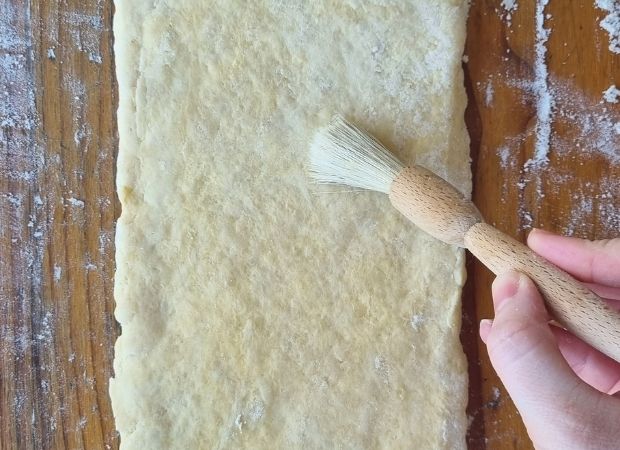Making pastry at home is easier than you might think, although a little messy at times. Plus it is very rewarding because the results are deliciously fresh and tasty!
Rough puff pastry is a butter-laminated pastry that’s a lot easier to make than puff pastry. The rolling and folding of the pastry, along with the butter, is what allows the pastry layers to be light, buttery and flaky when baked. As the pastry cooks in a hot oven, the heat allows the butter and water in the dough to create steam, which creates the flaky layers to form in the puff pastry.
For rough puff pastry, all you need are five ingredients, a scale, a palette knife and a rolling pin.
Start by measuring out your ingredients. You will want to be as exact as possible. You will need 250g of cake wheat flour (plus extra for dusting), a good pinch of salt, 190g of cold butter cut into cubes (each should weigh about 3g), 90ml of cold water (depending on the flour, you might need up to 30ml extra) and 5ml of lemon juice.
Step 1
Add the salt to the flour and mix it gently. It is very important to salt your flour as this will help enhance the overall flavour of the pastry once baked.
Step 2
Add one knob of butter to the the flour and use your fingers to rub it into the flour until the mixture resembles very fine breadcrumbs. Always use real butter for rough puff pastry as this really does elevate the flavour and overall quality of the pastry.
Step 3
Add 5ml lemon juice (you can use any acid of your choice) to the 90ml of cold water and add the lemon water mixture to the flour. Using a palette knife or a butter knife, cut the water into the flour to form a small shaggy dough. You might need to add a little extra water if the dough is too dry, but be careful not to add too much. Chunks of butter will still be visible in the dough mixture, which is fine. It is important to keep the butter cold, so the dough should be handled as little as possible to stop the butter from melting.
Step 4
Tip the dough out onto a floured surface and gently bring it together to form a ball. Lightly flour a rolling pin and roll out the dough to form a long flat rectangle. You can also roll the pastry out on baking paper to avoid adding too much flour to the dough as you roll it out.
Step 5
Before you begin folding and rolling, make sure you dust any excess flour off the top of the pastry. Fold the bottom third of the pastry over onto a third of the middle section of the pastry.
Dust any excess flour off and top with the remaining third of the pastry to form a small rectangle. Turn the folded pastry 90 degrees in a clockwise position. Repeat this roll-and-fold process four times with refrigeration breaks in between. You want to keep the butter from melting between each roll and fold.
NOW READ: 12 flaky, crispy and buttery pie recipes your family will love

